|
-
28th March 09, 04:20 PM
#1
X-kilt plus....
Plus what? Plus pockets, that's what. I'm planning four (two rear welted patch pockets, two front, inside a pleat pockets). I've done only the first rear one as yet.
Step one. Make most of an X-kilt according to Alan_H's instructions. Proceed to the point where you're ready to attach the waistband, basically.
Step two. try the kilt on, pin it right, and get someone else to mark where the pocket should be
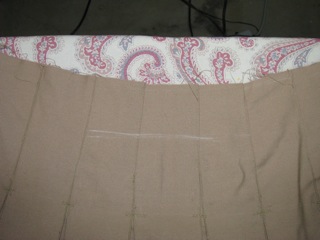
I'm making pockets with a six inch cut. That's the same size as my Utilikilt has, and seems about right. Note that I've made an error on placement: this line is two high. It's 2 1/8" from the top, and it's the center of a 3/4" cut, so the top of the pocket is just 1 3/4" from the waist band. I think they really need to be half or 3/4" lower than that. Also note that the line my helper marked isn't actually staight. That's okay: my waistband makes a suitable reference, and I'll measure from that for this next step, marking the ends of the cut line:
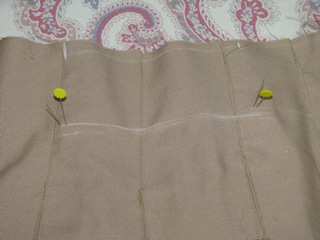
I stuck a pin from the top through, just inside of where I want the end to be. Then I stuck a pin from the back side at exactly where I wanted the end to be. Took a couple tries to get it exactly right.
Next I prepared the patch. I used a patch that's 9 inches wide by 6 tall. You need one that's at least two inches wider than your cut: one on each side. You need a couple inches of height, on each bottom and top. Top should be long enough that the top will be at the waistband. bottom should be about three inches, but don't go past the fell line. The extra thickness will effect the hang. Then I put interfacing on the wrong side of the patch. I used a fusible non-woven piece that was available.

Then we mark the patch with what will be the top and bottom welts of the pocket. I went for 3/4" wide, which is pretty typical for welted pockets. I marked those lines, the vertical stop lines, and a line halfway between the two welt lines, which is the cut line. Then the patch goes on to the kilt, right sides facing each other. The pins that I have sticking through the kilt were used to make sure I got the patch in just the right spot:
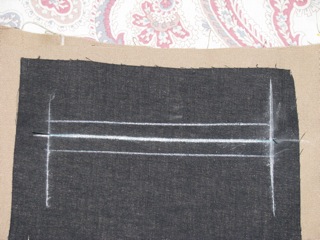
They don't show up well in that picture, but they exactly go through the intersection of the cut line and the vertical stop lines. It took a number of finger prickings to get that right. Then, I thoroughly pin the patch to the kilt:
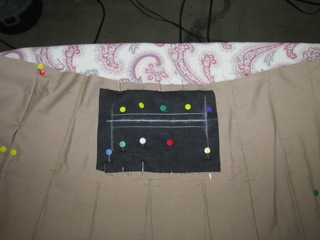
pins are placed so that they don't have to be removed to stitch on the lines.
Stitch exactly on each stitching line: the top welt line, the bottom welt line, and the two side welts. It's important to get stitches exactly in the right place, parallel, and not past each other. Back stitch away from the corner, at least half an inch. Make sure these stitches are perfect. If they're not square, you won't be able to make the pocket opening shaped right, and you'll have a saggy or wavy or buckled pocket. The next step is to slash a hole in your kilt, and you can't go back from there, so make sure these stiches are exactly right.
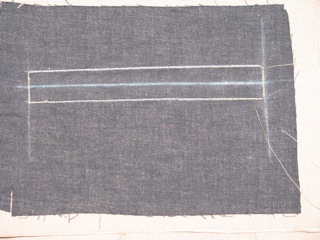
(you can't see the stiches, but they're there, and they're right. I ripped one out to redo it.)
Now, I cut out on the cut line. Make a vertical line 1/2" inside the edge stiches, one on each side. Using a very sharp razor or exacto knife, or something like that, make a short slash along the middle of the cut line. Then using very sharp, heavy duty shears (you're cutting through 6 to 10 layers of fabric) cut from the center slash to the vertical lines you just made. Cut from where you stop to each corner, coming as close as you possibly can to corner stitching, but dont' cut the stitching! So you're cutting out a line that's shaped like >----<
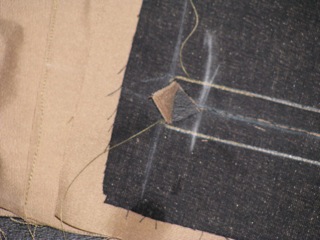
Now it's time to turn the patch through the hole forming the welts. I do the sides first, then the top, then the bottom. For the sides, you need to cut the patch, from the edge to very near the edge stitching, along a continuation of the top and bottom stiching lines. Make very sure you only cut the patch, and not the kilt! Then you fold the little rectangle you cut and the triangle piece in the cutout area back around, making the side welt. It should be about 1/8" inch wide, but even is much more important than exact size. Pin it in place, trying to get the pin through the triangle bit. (you need very sharp pins to go through that much fabric). Take the kilt to the pressing table, and press that welt in. Then stitch it in place, from the right side of the kilt. Stitch "in the ditch", right next to the folded bit. You'll also need to stitch down the rest of the rectangle. Because of where my pleats are, I could stich it the inside of a pleat, so there's no visible line of stitching.
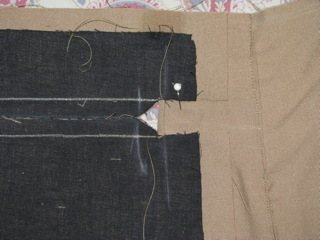
Do the same thing for the other side welt.
For the top welt, I cut out most of the flap of fabric that's in the cut out area. I wanted a small top welt, and it's impossible to fold that many layers up. Cut evenly, and very carefully. Fold the top part of the patch through the hole, form a nice even welt, pull the sides taut, and pin it in place. Then press, and sew it in the ditch. You probably want to turn the corner, and go halfway down each side.
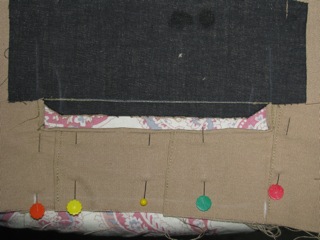
The bottom welt is slightly different: instead of being a narrow piece of fabric, it's tall enough so there's no gap between the top and bottom. So fold the bottom piece through (no need to trim), make the tall welt, pull it nice and smooth, and even, and pin it in place. Make sure there's no gap. Press it, stich it in the ditch. Again, you want to turn the corners and sew half way up the sides.
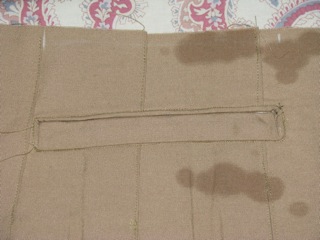
That's the outside of the pocket done.
the lining is much easier, though it involves some twisting and pushing to get it through the sewing machine. I used a single piece of cotton pocket lining material, 9 inches wide. that's 1 1/2 inches wider on each side, than the pocket cutout is; part is folded along the edges, to keep the raw edge of the fabric inside the pocket seam. To hang well, kilt pockets need to be very deep, so I simply used half my 45" wide pocket lining. That gives a depth of about 10", which should be enough. the selvedge end is attached to the wrong side of the bottom pocket patch, so that the patch is what you see inside the pocket. The fabric goes down the 10" or so, is folded on top of itself, up to the top of the top part of the patch, and down the wrong side of the top patch. That's hard to describe, but easy to do. I'm not allowed to put any more pictures in this post, so I'll do another showing that part.
-
-
28th March 09, 04:40 PM
#2
Here's the selvedge edge sewn onto the bottom patch:
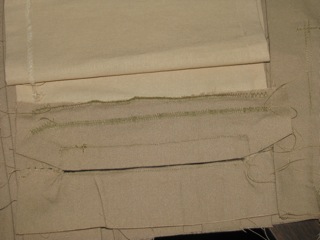
Once you sewn the top, sew up the sides, making the pocket a closed
pocket:
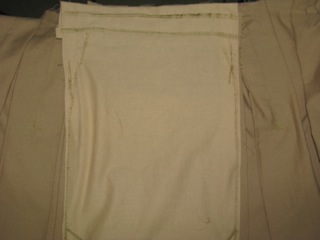
I put diagonal bar tacks at the bottom corners, to take pressure off
of the ends of hte seams.
Then I basted the pocket shut, because I'm going to do another, and
there's lots of handling, and I don't want it streched out.

I'll post the rest as I finish the various stages....:
~
-
-
29th March 09, 02:10 PM
#3
front pocket
the right front pocket goes in between the first two normal pleats on the right side, so I've got to undo the stitching that holds that pleat down. It would have been cleverer to have not stitched this down, but well, i wasn't sure where this pocket would end up.
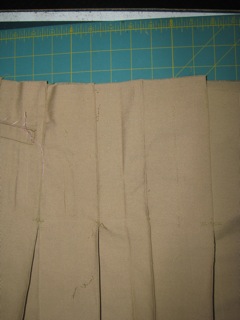
I edge stitched this pleat all the way to the waistband.
then I marked the line that will be slashed out. I went at the inside crease of this pleat, two inches from the waistband, and extending five inches.
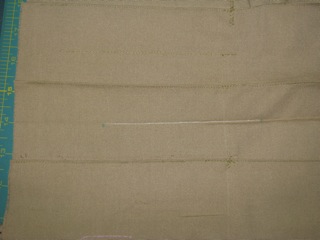
then I prepared the patch. The patch is five inches wide, and 9 long. The slash is 1.5 inches from the bottom, and centered in the five inche side. The extra on the top is so that the patch can be sewn into the waistband, which should keep the pocket from pulling the kilt out of shape.
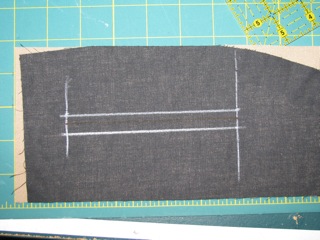
The slash on this one is only 1/2 inch wide. the patch is then pinned precisely in place.
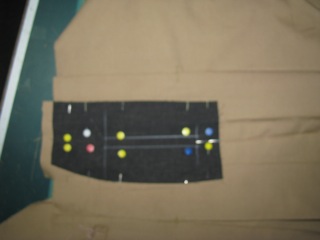
(I'll not show you the picture where I've very carefully pinned it in the *wrong* place....)
Then I carefully stitched the box into place.
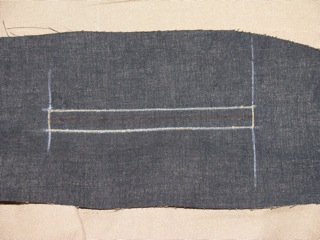
Cut out the slash, again stopping about 1/2 from the end, and making a >--< shape.
I cut the top and bottom pieces of the patch differently from the rear pockets. 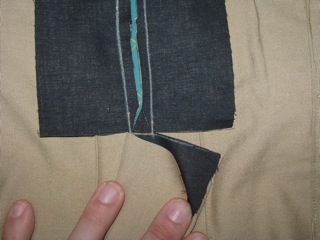
Again, that's so we can get the patch into the waistband.
Welts are pulled through, pinned, pressed, and stitched. I did top first, then the bottom, then the two sides.
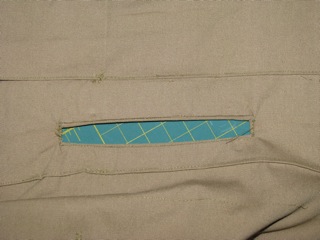
Here's what it looks like on the inside.
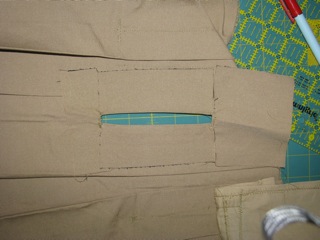
Last edited by vorpallemur; 30th March 09 at 10:51 AM.
Reason: fix layout tags
-
-
29th March 09, 03:08 PM
#4
The Barry
"Confutatis maledictis, flammis acribus addictis;
voca me cum benedictis." -"Dies Irae" (Day of Wrath)
-
-
29th March 09, 06:12 PM
#5
front pocket lining
The lining for this front pocket is a single piece of pocket lining cotton, same as the back. It's attached and assembled in a rather different way, though. First I cut out a piece of fabric and hems in it (it's got four raw edges). finished dimension is 14" wide by about 17" deep. I also a attached a smaller inner pocket for my cell phone. the pocket is rather cavernous, and I suspect the phone would get lost.
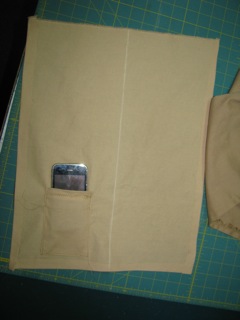
The white chalk line is where the pocket will be folded, forming the back edge. It's also where I cut a 1/2" wide by 5 1/4" inch slot, to pull the patch through.
I forgot to take a picture of it in that state, but here it is with the patch pulled through:
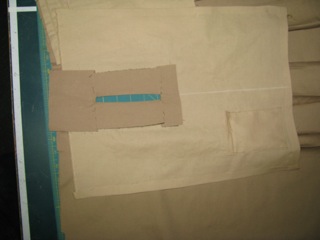
The lining then gets sewn to the patch, both close to access hole, and at the edges of the patch. Again, I forgot to take a picture, but you can probably figure it out. Having done that, I sewed up the three open sides of the pocket:
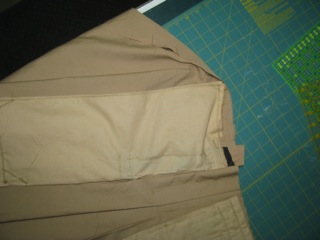
Like the rear pockets, I've got diagonal bar tacks at the bottom to keep stress off the corners. I also sewed about an inch and a half up the back edge, for the same reason. (bad picture, can't see that well, sorry)
What it looks like from the outside:

Then I sewed the pleat down, from the waistband, to the start of the pocket opening. I put a bar tack connecting the pleat the pocket is under to the pleat behind it. This shows that, after I pressed it flat.
I'm going to do the pocket on the other side differently. I haven't figure out how it will work, yet, though, so I'm going to think about it for a while.
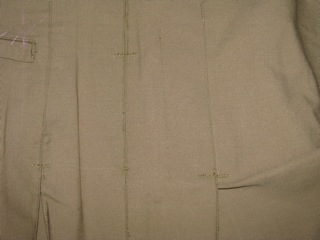
Last edited by vorpallemur; 30th March 09 at 10:54 AM.
Reason: added picture link
-
-
30th March 09, 09:16 AM
#6
That is seriously impressive! It's several levels above my current sewing ability, but I'm bookmarking this thread for someday in the future.
David
-
-
30th March 09, 09:23 AM
#7
Very nice job. I'd looked at welt pockets but never got 'round to them. IIRC the welt pocket on Bob's Union Kilt has a flap over it, DIYers keep that in mind in case you b*gger it up on your first attempt  i.e. good way to hide a less-than-perfect appearing welt. i.e. good way to hide a less-than-perfect appearing welt.
No flaps required in this post! Thanks for sharing your journey.
Proudly Duncan [maternal], MacDonald and MacDaniel [paternal].
-
-
30th March 09, 11:25 AM
#8
I put the kilt on, and put some things in the front pocket. I don't like the way it hangs, not at all. I'm goint to rip it out, and try something else. In particular, it needs to be more forward. And there's too much material in the bottom part of the patch. (I'd also like it if this were a deeper pleat, but I can't do anything about that on this kilt. Next time....) Making the pocket not a straight box complicates assembly. I'll have to do some mock ups.
-
-
30th March 09, 08:37 PM
#9
So, ripped out the pocket, figure out what I wanted to do. I discovered I didn't have enough lining material to cut out one piece, so I decided to try and piece it out of what I had made the first go out of. Well, I screwed up. I'm so sick of ripping seams....
-
-
31st March 09, 12:03 AM
#10
 Originally Posted by vorpallemur

I put the kilt on, and put some things in the front pocket. I don't like the way it hangs, not at all. I'm goint to rip it out, and try something else. In particular, it needs to be more forward. And there's too much material in the bottom part of the patch. (I'd also like it if this were a deeper pleat, but I can't do anything about that on this kilt. Next time....) Making the pocket not a straight box complicates assembly. I'll have to do some mock ups.
I would go for slash pockets instead of front pocket.
Otherwise good tutorial. Thanks!
I like the breeze between my knees
-
Tags for this Thread
 Posting Permissions
Posting Permissions
- You may not post new threads
- You may not post replies
- You may not post attachments
- You may not edit your posts
-
Forum Rules
|
|













































Bookmarks